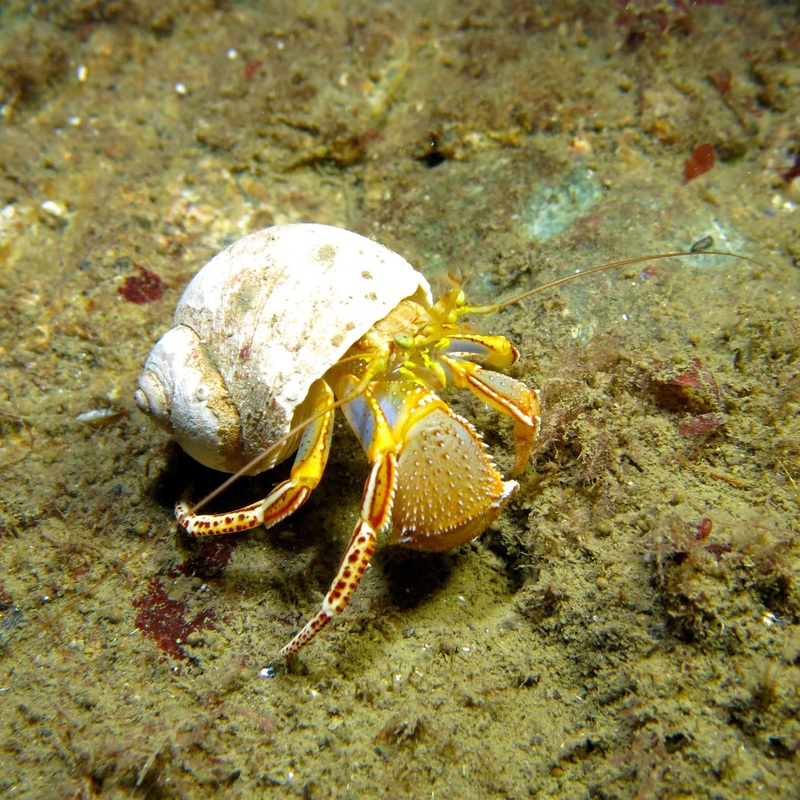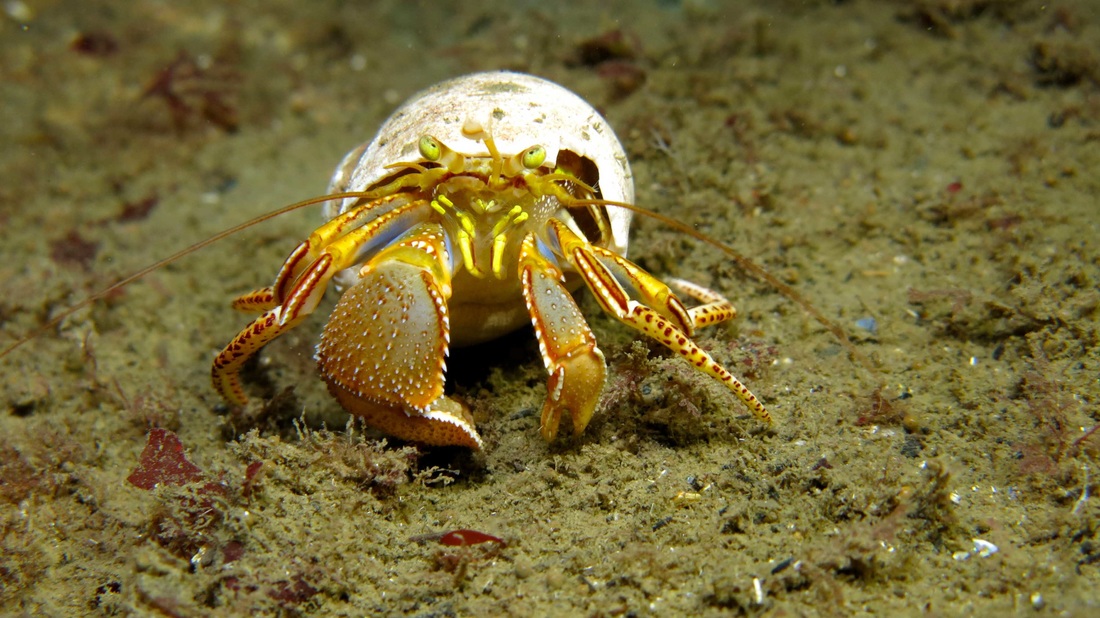Widehand hermit • Elassochirus tenuimanus
Identification
This colourful hermit crab can be identified by the purplish-blue patches on one of the inner segments (merus) of its walking legs, as well as its disproportionately large and flattened right claw which has a granular surface and spiny margins. The hermit crab's carapace and appendages are reddish-brown, orange, yellow, and white. The carapace reaches around 5 cm long.
Habitat & Range
The widehand hermit inhabits the intertidal and subtidal to 388 m deep. It can be found on a variety of sediments, from sand and mud to gravel, rock, shell, or mixed; however it is most common in areas near rocky outcrops. Its range extends from the Bering Sea and Aleutian Islands in Alaska to Puget Sound, Washington.
Intriguing Info
While the comically large right claw seems like it could be cumbersome for movement, the widehand hermit gets along quite well by bending it beneath its body while walking. The claw comes in quite handy as a protective barrier when the hermit crab retreats into its shell, as it successfully blocks the shell's aperture.
iNaturalist
https://www.inaturalist.org/taxa/459569-Elassochirus-tenuimanus
This colourful hermit crab can be identified by the purplish-blue patches on one of the inner segments (merus) of its walking legs, as well as its disproportionately large and flattened right claw which has a granular surface and spiny margins. The hermit crab's carapace and appendages are reddish-brown, orange, yellow, and white. The carapace reaches around 5 cm long.
Habitat & Range
The widehand hermit inhabits the intertidal and subtidal to 388 m deep. It can be found on a variety of sediments, from sand and mud to gravel, rock, shell, or mixed; however it is most common in areas near rocky outcrops. Its range extends from the Bering Sea and Aleutian Islands in Alaska to Puget Sound, Washington.
Intriguing Info
While the comically large right claw seems like it could be cumbersome for movement, the widehand hermit gets along quite well by bending it beneath its body while walking. The claw comes in quite handy as a protective barrier when the hermit crab retreats into its shell, as it successfully blocks the shell's aperture.
iNaturalist
https://www.inaturalist.org/taxa/459569-Elassochirus-tenuimanus
References
Cowles, D. Elassochirus tenuimanus (Dana, 1851). Invertebrates of the Salish Sea. Rosario Beach Marine Laboratory. Accessed 26/11/2015.
Hart, J. Elassochirus tenuimanus (Dana, 1851). In Klinkenberg, Brian. (Ed.) E-Fauna BC: Electronic Atlas of the Fauna of British Columbia. Lab for Advanced Spatial Analysis, Department of Geography, University of British Columbia, Vancouver. Accessed 26/11/2015.
Jensen, G.C. (1995). Pacific Coast Crabs and Shrimp. Monterey, CA: Sea Challengers. P. 60.
Lamb, A., and Hanby, B. (2005). Marine Life of the Pacific Northwest [electronic version]. Madeira Park, BC: Harbour Publishing.
Authors and editors of page
Kelly Fretwell (2015).
Cowles, D. Elassochirus tenuimanus (Dana, 1851). Invertebrates of the Salish Sea. Rosario Beach Marine Laboratory. Accessed 26/11/2015.
Hart, J. Elassochirus tenuimanus (Dana, 1851). In Klinkenberg, Brian. (Ed.) E-Fauna BC: Electronic Atlas of the Fauna of British Columbia. Lab for Advanced Spatial Analysis, Department of Geography, University of British Columbia, Vancouver. Accessed 26/11/2015.
Jensen, G.C. (1995). Pacific Coast Crabs and Shrimp. Monterey, CA: Sea Challengers. P. 60.
Lamb, A., and Hanby, B. (2005). Marine Life of the Pacific Northwest [electronic version]. Madeira Park, BC: Harbour Publishing.
Authors and editors of page
Kelly Fretwell (2015).






